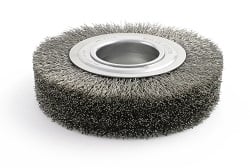 Metal fabricators use steel wire wheel brushes for surface preparation, surface finishing, burr removal, weld cleaning, and rust and oxide removal. Wheel brushes with steel filaments aren’t just versatile, however. They’re also dependable. For example, steel wire tips remove contaminants, coatings, and surface imperfections without changing part dimensions. Steel wire brushes are also non-loading, which means that they won’t become clogged with debris.
Metal fabricators use steel wire wheel brushes for surface preparation, surface finishing, burr removal, weld cleaning, and rust and oxide removal. Wheel brushes with steel filaments aren’t just versatile, however. They’re also dependable. For example, steel wire tips remove contaminants, coatings, and surface imperfections without changing part dimensions. Steel wire brushes are also non-loading, which means that they won’t become clogged with debris.
Steel Wire Wheels for Surface Finishing
Are steel wire wheel brushes what you need? Are you using them at your shop now, or have you tried this type of power brush before? Whether you’re an experienced parts fabricator or new to metalworking, it’s important to select the right type of steel wire wheel and then follow some best practices. For example, did you know that tempered steel wire costs more but lasts longer? Did you know that brushes are set-up to run at a prescribed surface feet per minute (SFM), and that larger-diameter brushes can achieve this SFM while running at lower revolutions per minute (RPM) than small-diameter brushes? Let’s look at some brush tool tips.
Fill Materials and Twist Types
Steel wire wheel brushes use either carbon steel or stainless steel as the fill material. Carbon steel has good wear characteristics, cutting action, and fatigue resistance. Stainless steel resists wear, corrosion, high temperatures, and some chemicals. Fill material matters, but you’ll need to consider the twist type, too. Crimped wire or standard twists are used with regular surfaces. Knotted or tufted cable twists are more aggressive. Stinger bead twists have a narrow face and are used mainly for weld cleaning.
Filament Length and Fill Density
Filament length and fill density can vary, so make sure to choose and use the right type of steel wire wheel for the job. Brush tools with longer filaments or trim conform closely to contoured surfaces. Brushing tools with shorter trim are better-suited for more demanding applications. Fill density, the number of steel wire tips per unit of measure, also affects performance. Steel wire wheels with lower densities are more flexible, and are a good choice for surface cleaning. Higher-density wheels can run faster and last longer.
Brush Speed and Direction
Like other power brushes, steel wire wheels work best when the brush speed and pressure are right for your specific application. As a rule, use the highest possible speed and the lightest possible pressure. Never exceed the maximum safe free speed (MSFS) or revolutions per minute (RPM), however, and avoid applying so much pressure that the filaments get too hot or bend too much. If you need to apply greater pressure, try a more aggressive brush. For longer brush life, periodically reverse the direction of rotation.
Stainless Steel Brushes – Special Considerations
Steel wire wheels are non-loading, but that doesn’t mean a condition called “after rust” can’t affect your workpiece. To avoid this problem, don’t use a stainless steel brush on carbon steel parts and then on stainless steel parts. Keep your stainless steel brushes away from areas where they might contact carbon steel particles, too. For critical tasks, degrease stainless steel wire wheels before starting operations. When you’re done, degrease these wheel brushes again and wrap them in plastic.
Learn More About Industrial Brushes
As a full-line manufacturer of surface finishing solutions, Brush Research Manufacturing (BRM) supplies metal fabricators with a large and growing family of industrial brushing tools. For more information about our steel wire wheels and other surface finishing and deburring tools, download “The Use of Industrial Brushes” now and read it right in your web browser.









